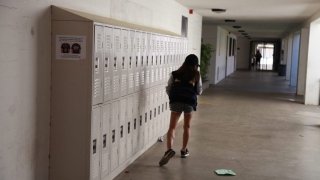Perhaps the first step in fixing student homelessness in Los Angeles is to understand where students experiencing homelessness are. And yet that hasn’t been so easy.
But using nine years of data gathered by Los Angeles Unified School District, USC Rossier graduate Tasminda Dhaliwal PhD ’21 is leading research into where these students live throughout the city, how they move between schools and what gaps exist in supports.
Dhaliwal’s study is among the first to provide evidence about where students experiencing homelessness are concentrated and shows that these students transfer schools frequently.
“Students who become homeless have substantial school mobility and neighborhood mobility,” Dhaliwal says. “Once they’re identified, they still exit or change schools at higher rates and exit the district at higher rates, so some of the supports that are supposed to exist just aren’t being implemented.”

The data, collected between 2008-2017, show that many such students tend to be clustered in lower-achieving schools, where students are more likely to be eligible for free- and reduced-priced lunch. These schools also enroll higher proportions of students of color and English-learners, and tend to be in economically disadvantaged neighborhoods. But wealthier neighborhoods have these students too, the data shows.
Almost a quarter of LAUSD schools have homeless rates above 5 percent, the study found, raising questions about whether those schools have enough resources to adequately support students.
Both homelessness and mobility are associated with negative effects on children. Homeless students may do worse in school and have more behavioral issues than their peers. And while research on mobility shows mixed effects (depending in part on what school the student transfers into), research also suggests that mobility negatively affects the non-mobile students in a school, as well.
Law versus reality
The McKinney–Vento Homeless Assistance Act defines homelessness as lacking a fixed, adequate and stable nighttime residence, including residences with multiple (doubled-up) families.
First passed in 1987, the McKinney-Vento Act provided federal funding to counter the effects of homelessness. The law is supposed to help keep students experiencing homelessness from switching schools, but Dhaliwal’s research is helping to reveal cracks in the law’s effectiveness.
Dhaliwal says McKinney-Vento’s supports are underfunded, but notes that there could also be information gaps, where families identified as homeless aren’t given enough information about their rights. Students may also miss the threshold for transportation aid, and even if they do qualify, that aid doesn’t extend to family.
“If families or parents ever get called into the school for a parent-teacher conference or something else comes up,” Dhaliwal says, “it’s just going to be more of a struggle to get there as well.”
A housing boom and a financial crunch
Dhaliwal graduated from USC Rossier’s PhD in Urban Education program in May, and will begin work this summer as an assistant professor at Michigan State University.
She became interested in studying homelessness while teaching 1st and 2nd graders in Houston; the elementary school was across the street from transitional housing for the city’s largest homeless shelter.
“I had students in my school and in my classroom who were accessing that transitional housing and who were experiencing homelessness themselves,” she says. “I had students moving in and out of my classroom.”
Moving to Los Angeles for her PhD program furthered her interest, both in how she herself experienced the high cost of living and through seeing widespread homelessness close up. A 2020 count from the Los Angeles Homeless Services Authority (LAHSA) showed a 12.7 percent increase in Los Angeles County homelessness over 2019, and a 2019 count by LAUSD identified more than 17,000 students experiencing homelessness.
In April, the median housing price jumped to more than $650,000, a record that followed a series of previous records. Los Angeles has long had some of the highest rental prices in the country, even as the COVID-19 pandemic caused a slight decline.
“We know that children in families that pay over 30 percent of the income in rent suffer higher levels of physical and mental health distress and perform worse in school,” says Professor Gary Painter, director of the Sol Price Center for Social Innovation and a co-author on Dhaliwal’s most recent study. Other study co-authors include Soledad De Gregorio, a postdoctoral scholar at the Sol Price Center for Social Innovation, and USC Dornsife Associate Professor of Sociology Ann Owens.
“People in the United States often take an individual deficit view of homelessness, thinking folks have mental illness or substance abuse that is leading to them being homeless,” Dhaliwal says. “That does happen, but what we’re seeing, especially around family homelessness, is a lot of these structural issues around the lack of affordability, that property values are going up but wages have been stagnant for folks who are in working-class jobs.”
How schools can do more
The silver lining to Dhaliwal’s findings is that students who transfer schools are often moving to relatively similar or even better schools in terms of accountability metrics—mostly “lateral moves,” as she calls them, but not downward moves.
But how much a school knows about its students’ mobility isn’t as nuanced as it could be. For instance: When a student changes schools, they have to fill out a student residency form that questions their housing status, which is then used to identify which students are homeless. But when a student changes addresses without changing schools, that change might not be flagged—yet it should be, Dhaliwal says.
“Schools—and districts, more generally—have an opportunity to be proactive and use any kind of mobility as a flag to have that student residency questionnaire filled out,” she says.
In addition, Dhaliwal suggests better coordination at the county level, including broadening the scope of Los Angeles County to help track homelessness and mobility across the county.
And along similar lines, groups outside of school districts also have to contribute to addressing youth homeless: Businesses, housing authorities, nonprofits and others.
“The school district isn’t, shouldn’t and doesn’t have the capacity to be a real estate developer,” Dhaliwal says. “Helping homeless students is going to take a cross-sector collaboration.”




